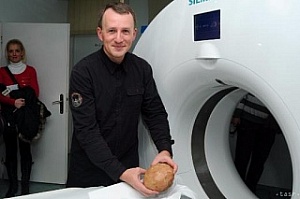On October 18 and 19, Martin Kundrát, head of the PaleoBioImaging laboratory of the University of Paul Josef Shafarik (Kosice, Slovakia), and an employee of the European Synchrotron Radiation Facility (ESRF) will speak at TSU with open lectures. The scientist will present the results of the latest studies, within the framework of which new data on embryology of dinosaurs were obtained and an earlier unknown type of archeopteryx was discovered.
- The eggs of the ancient lizards are an extremely rare find, so in the process of studying them it is important to use gentle methods that will allow you to obtain maximum information without damaging the unique object, - says paleontologist Martin Kundrát. -The research accelerator complex, located in Grenoble, makes it possible to enlighten the object with a powerful beam of radiation and see its microstructure from the inside.
With the help of this non-invasive method, scientists investigated the eggs of carnivorous and herbivorous dinosaurs found in Patagonia, China, and the USA. They could see not only the skin, muscles and, cartilage of dinosaur embryos but also the corpus luteum that nourished the fetus.
Along with this, during a speech at TSU, Martin Kundrát will talk about a new type of archeopteryx discovered using synchrotron studies. Remains of an ancient bird were found in Bavaria. According to scientists, the individual lived on the territory of modern Germany at the end of the Jurassic period, that is, about 150 million years ago. According to research, a new type of archeopteryx is also the youngest on the planet
The visit of Martin Kundrát to Tomsk State University is of a working nature, the paleontologist from Slovakia is discussing a joint project with scientists from the TSU’s Laboratory of Mesozoic and Cenozoic Continental Ecosystems.
Topics of lectures:
- October 18 (Wednesday), audience №245 of the main building
14:25 - 16:20 Modern Ideas About Embryology of Dinosaurs
- October 19 (Thursday), audience №245 of the main building
14:45 - 16:20 A New Species of Archeopteryx (synchrotron research results)
The entrance is free. The language of the lections is English
Associate Professor Martin Kundrát is the head of the laboratory PaleoBioImaging, the head of the research group Archosaur Evo-Devo of the Center for Interdisciplinary Biological Sciences of the Park of Technologies and Innovations of the University of Pavel Jozef Šafárik.
The paleontologist from Slovakia is a pioneer in the use of computerized tomography techniques in paleobiology.

